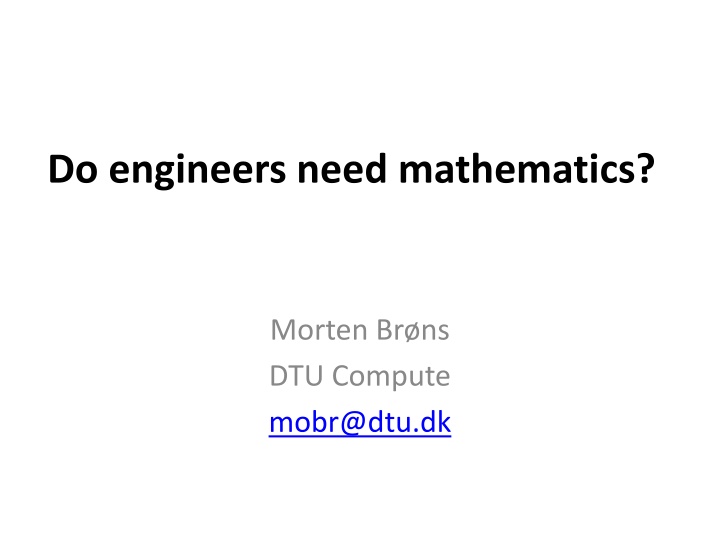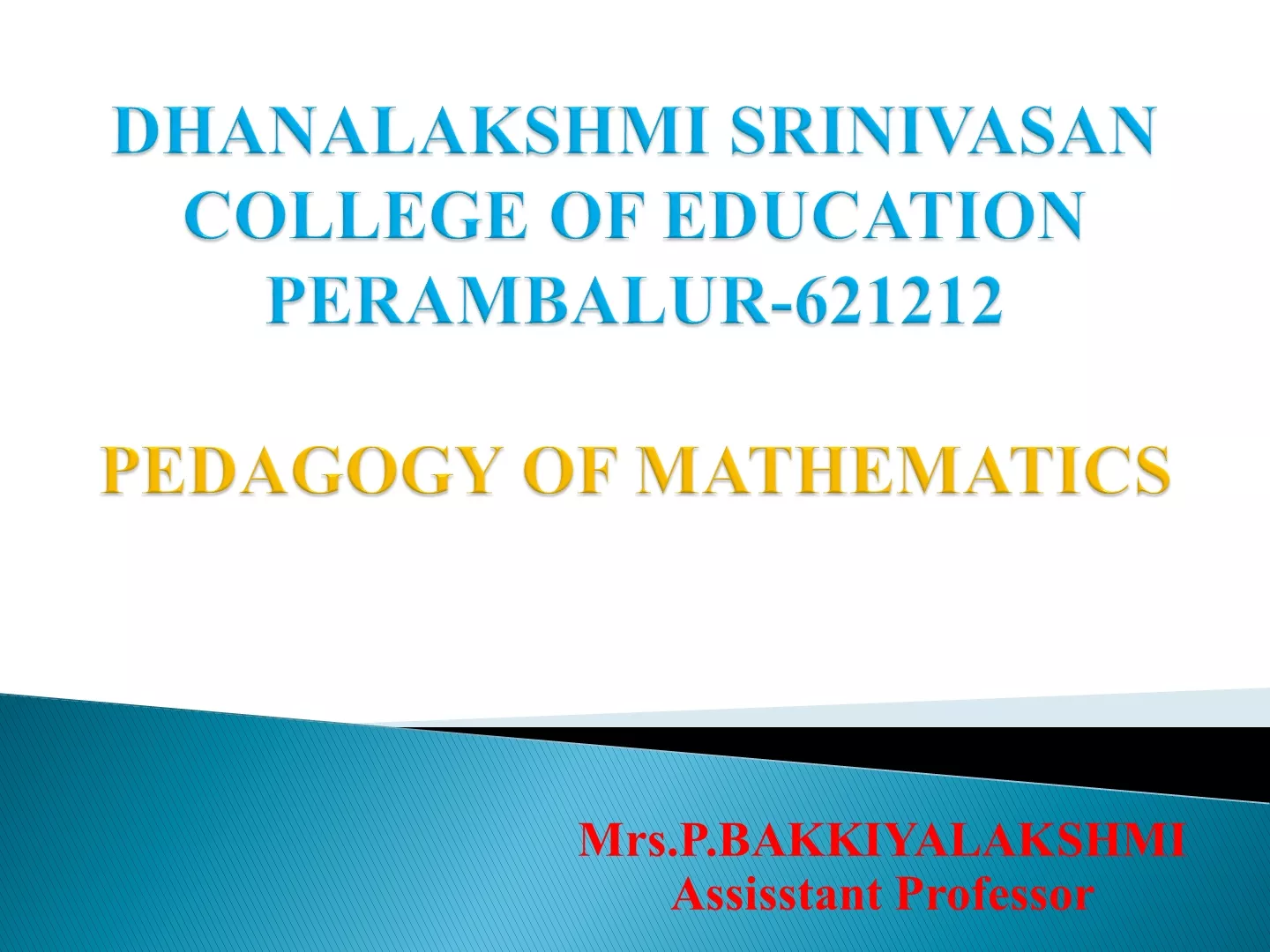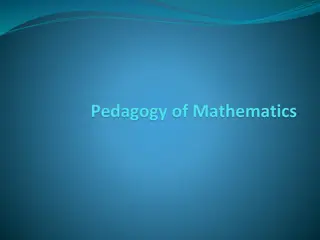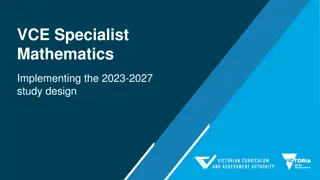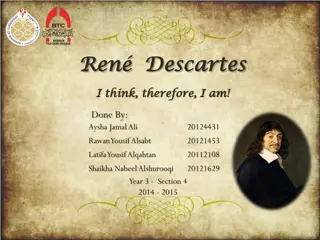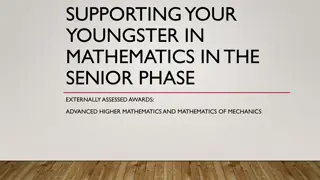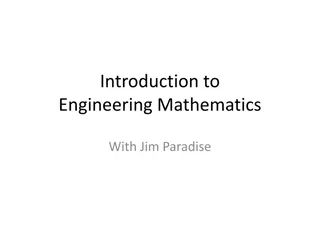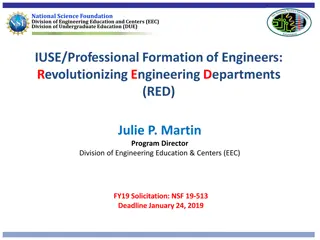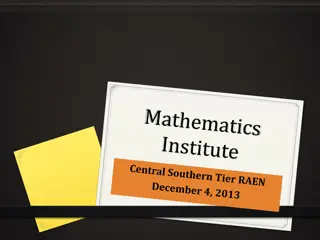The Vital Role of Mathematics in Engineering Education
Engineers require a solid foundation in mathematics to tackle complex problems effectively. Mathematics is a fundamental tool that is intertwined with all engineering disciplines, emphasizing abstract thinking and problem-solving skills. At DTU, mathematics courses for B.Eng. students cover topics like complex numbers, differential equations, matrices, and more, with a focus on practical applications in engineering projects. The teaching philosophy stresses the importance of understanding the abstract nature of mathematics to optimize its use in engineering. Projects, such as analyzing wind-induced oscillations of a bridge, demonstrate the real-world application of mathematical concepts in engineering solutions.
Download Presentation

Please find below an Image/Link to download the presentation.
The content on the website is provided AS IS for your information and personal use only. It may not be sold, licensed, or shared on other websites without obtaining consent from the author.If you encounter any issues during the download, it is possible that the publisher has removed the file from their server.
You are allowed to download the files provided on this website for personal or commercial use, subject to the condition that they are used lawfully. All files are the property of their respective owners.
The content on the website is provided AS IS for your information and personal use only. It may not be sold, licensed, or shared on other websites without obtaining consent from the author.
E N D
Presentation Transcript
Do engineers need mathematics? Morten Br ns DTU Compute mobr@dtu.dk
Two philosophies of engineering education and practice The engineer as a scientist The engineer as a skilled craftsman
The history of the B.Eng. educations 1881: IHK Founded as Day School for Builders and Machine Builders educating Teknikumingeni rer 1957: Danish Engineering Academy (DIA) formed on the DTU campus, providing a 4-year education as Akademiingeni r 1993: The degrees Teknikumingeni r and Akademiingeni r harmonized to Diplomingeni r (B.Eng.) 3 years including year internship 1995: DIA merges with DTU 2013: IHK merges with DTU
Mathematics for B.Eng. at DTU before the fusion Two 5 ECTS courses common for all study lines DiploMat 1: Complex numbers, polynomials, Taylor s formula, first and second order differential equations, partial derivatives DiploMat 2: Systems of linear equations, matrices, eigenvalues and -vectors, systems of linear differential equations, extrema for functions of several variables One or two projects on a problem emerging from engineering Use Maple for projects and as a dynamic answer book compute by hand check with Maple Weekly lectures and excercise sessions with a TA. Written exam
Teaching philosophy Mathematics is a tool and a way of thinking which pervades all engineering disciplines. To make best use of mathematics in engineering it is crucial to understand its general and abstract nature Proofs are given only if they illuminate the use of the theory Engineering applications concentrated in projects allows a common course for all study lines
Project example Wind-induced oscillations of a bridge How to choose the material constants to avoid the brigde falling down for realistic wind speeds?
Another point of view Engineering students basically are not interested in math for math they are interested in mathematical applications, and most maths can be treated as black boxes, which gives a predefined output for a given input. Somebody has to determine the mechanics inside the black box, but the user don t have to know this in detail or too prove it is true, as long as the user knows the limits of allowable inputs and how to evaluate the output. Engineers are used to this kind of work. Quote from Math for Engineers , draft working paper, Hans Peter Christensen, 2015(?)
Merging attempt #1 The mathematical demands for all study lines can t be covered by common 10 ECTS courses New course BasisMat essential identical to Diplomat 1 covering topics of interest for all study lines New idea: ModulMat short sequences of math to be taught in applied courses when needed.
The modules Systems of linear equations and matrix algebra (4 weeks) Determinant, eigenvalues, eigenvectors (3 weeks) Functions of several variables, Taylor polynomials in several variables, Hesse matrix (2 weeks) Planar integrals, rectangular and polar coordinates (2 weeks) Systems of differential equations (2 weeks) Fourier transform (2 weeks) Laplace transform (2 weeks) Logic: predicate logic, quantors, induction (6 weeks) Difference equations and Z-transform (3 weeks) Singular value decomposition of 2x2 and 3x3 matrices (3 weeks) Infinite series, Fourier series (3 weeks) Curves and curvature (3 weeks)
Practicalities Each study line must choose modules of total extent 13 weeks, corresponding to 5 ECTS The modules can be implemented at the discretion of the study leader The course evaluation must also evaluate the math modules, and they must appear in the learning goals Optional teaching material provided by DTU Compute for each module
How did it go? Electrical and Mechanical Engineering: We need so much mathematics that we want a course in linear algebra and Fourier series The Dean: Single line of responsibility only the study leaders are responsible for implementation of the modules, not DTU Compute Very few modules were actually implemented
So what? The module concept was dumped and a new course in linear algebra with applications (BasisMat 2) is now compulsory for all study lines 9 weeks of basic linear algebra, 3 weeks specialization Track A: Extrema for functions of two variables, over- determined systems of linear equations Track B: Systems of differential equations with periodic input, transfer functions Same structure as BasisMat 1 lectures, exercises, projects
Merging attempt #2 For the study line Civil Engineering and Infrastructure a special version of BasisMat 1 combining calculus and mechanical physics was tested in 2017 Four cases of 1. Modelling a physical problem with differential equations 2. Learning the mathematics needed to solve the equations 3. Solving the physical problem
The four cases 1. A body falling through through liquid concrete (First order DE) 2. Vibrations of a table, heavily damped or undamped (Second order homogeneous DE with exponential or harmonic solutions) 3. Lightly damped wind turbine tower (Complex numbers, general solution to second order homogeneous DE) 4. Wind turbine tower with external load (Second order inhomogeneous DE)
How did that go? Student response Physics too difficult and demanding too much work The teaching styles in math and physics are too different Q: The course mixes maths and physics. Is that motivating for your work? Very Somewhat motivating Doesn t matter Not motivating motivating 4% 48% 28% 20%
What would I do differently? Let mathematics support engineering topics that are central to the study programme but I wouldn t do it again. 16 B.Eng. study lines implies 16 different courses
Challenges for our B.Eng. students Approx. 50% of the students have the grade 4 (D) or less in mathematics from high school Definition of the grade 4: For a fair performance displaying some command of the relevant material but also some major weaknesses
How to teach complex numbers? BasisMat 1: Start the course with complex numbers. Pro: Opportunity to refresh basic algebra in a new context Experimental course: On-demand when needed to solve differential equations Pro: Strong motivation
Conclusions Mathematics-driven courses with connection to engineering through projects is a robust structure Student motivation seems not to be a problem How to assess if the teaching actually works?
